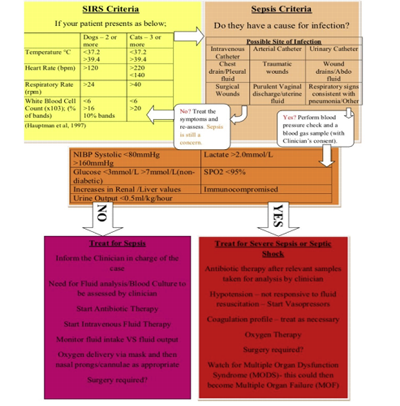Delivering consistent quality care: Care plans, care bundles and integrated care pathways
This is article twenty-nine in an RCVS Knowledge series of features on patient safety, clinical human factors, and the principles and associated themes of Quality Improvement (QI).
Lucy was nervous: it was her first day at her new job and as she sat waiting in reception to be greeted by the head nurse she wondered if she had made a terrible mistake.
Lucy had trained and qualified as a veterinary nurse at a small branch surgery where the team offered excellent care and compassion. In return, she had enjoyed working with loyal and friendly clients. She knew just where everything was and how everything worked. But Lucy also loved learning and wanted to specialise in emergency care; from today she would work in a 24-hour veterinary hospital as an Intensive Care Unit (ICU) nurse.
Ginny had been head nurse at the hospital for 12 years and prided herself on ensuring that new members of the team were supported in their role. She was looking forward to mentoring Lucy and sharing tips and tricks about the exciting and fast paced ICU nurse role. As Ginny greeted Lucy warmly in reception, she noticed she looked a little nervous.
While they walked to the ICU Ginny asked if Lucy had any questions.
Lucy sheepishly replied, “I have to be honest; I am really nervous, I’m worried I will never remember everything and might not know what to do.”
Ginny smiled, “Oh gosh, please don’t be nervous. Someone once told me that you can only remember a maximum of seven things at a time. So we have created lots of things to help us offer consistent and evidence-based care. I thought we would spend this morning looking at some of them”.
Veterinary hospitals are known to be complex, sociotechnical systems that must respond to patients needs in a dynamic and contextualised manner. To ensure we have consistent quality of care, it is vital that we adopt systems and processes to support our team members to deliver high standards of care. Within the veterinary ICU, two useful evidence-based tools are care plans and care bundles.
Care plans
Care plans are a written record of the care planning process. These work to recognise a patient’s actual and potential problems with interventions to assist in addressing them2. Care plans are based on models of nursing such as the Orpet and Jeffery Ability Model1.
There are several benefits of planning nursing; it provides an opportunity to prepare the patient and the environment for care interventions, it ensures that individualised and measurable goals for treatment are identified and set, and generates a written care plan that can be used to ensure continuity of care –whether a patient is being cared for as an inpatient or at home by their owners.
Advantages of using nursing care plans2
For the patient:
- Promote’s a holistic approach to patient care
- Improves continuity of care
For the professional:
- Improved teamwork and communication between teams
- Can be used to evaluate care retrospectively and inspire continuous improvement
- Supports the professional aspirations of veterinary nurses by offering accountability, learning, and job satisfaction
- Empowers veterinary nurses to work independently and advocate for their patients
Ginny explained that each patient had a care plan that was completed and updated daily during their stay to ensure that none of their needs were being overlooked.
Care bundles
A care bundle consists of a group of between three and five evidence-based interventions. When executed together, they result in a better outcome than if they are implemented individually. These are related to a particular condition or event in patient care. Key principles state that there should be a high level of adherence to all components, they should be standardised, and it should be possible to audit whether all components have been completed.
Using care bundles should reduce unwarranted variations in care and prevent omissions of clinical care due to human error.
In human healthcare, care bundles have featured in several human healthcare campaigns such as:
- The 100,000 lives campaign: this campaign was run by Institute of Healthcare Improvement (IHI) to significantly reduce the levels of morbidity and mortality. They asked participating hospitals to extend or save as many as 100,000 lives, The Central Line bundle and the Ventilator bundle were introduced as two of the six steps that were encouraged to achieve this aim.
- The surviving sepsis campaign: a global initiative to reduce morbidity and mortality from sepsis in both human and veterinary patients. It is a joint initiative between the Society of Critical Care Medicine and the European Society of Intensive Care Medicine. The partnership provides consensus guidelines for a bundle that should begin in the first hour from sepsis recognition. Research showed that using this bundle reduces the chance of the patient dying in hospital by 40%3.
Table 1: The 5 Key Elements of the Surviving Sepsis Campaign Hour-1 Bundle4.
Adapted from Care Bundles in Intensive Care4.
| 1 | Measure lactate level |
| 2 | Obtain blood culture samples before administering antibiotics |
| 3 | Administer broad-spectrum antibiotics |
| 4 | Begin rapid administration of 30ml/kg crystalloid for hypotension or lactate ≥4 mmol/L |
| 5 | Apply vasopressors if the patient is hypotensive during or after fluid resuscitation to maintain mean arterial pressure ≥65mmHg |
In 2016, the Surviving Sepsis Campaign, sepsis bundle was adapted for use in veterinary intensive care units5.
SEPSIS BUNDLE for Veterinary Patients in the Intensive Care Unit

Produced by Katherine Gray RVN, November 2016. Adapted from Surviving Sepsis Campain Sepsis 6 Care Bundle. Shared with permission from Katherine Gray. Download a copy [PDF 168kb].
Ginny showed Lucy where the care bundle folder was kept – she explained that each bundle was laminated so you could take one and attach it to the patient’s kennel door. As you completed the bundle, you used a marker pen to tick off the stages, therefore making sure that you did not forget anything.
Integrated Care Pathways
An Integrated Care Pathway (ICP) is a document that stays with the patient throughout their care. All professional groups (including surgeons, nurses, anaesthetists, and physiotherapists) involved in providing care come together to agree on a plan of care prior to an elective surgical intervention. ICP’s can also include owner education for home care and financial planning.
ICP’s are structured multidisciplinary care plans that detail essential steps in the care of patients with specific clinical problems⁶. They have been proposed as a way of encouraging the translation of evidence-based guidelines into local protocols and their subsequent application to clinical practice. They have also been successfully adopted in human healthcare.
Ginny explained that Integrated Care Pathways are another checklist style record of care that ensures that standardised care is offered consistently to patients who are in a specific patient group. For example, the orthopaedic injury care pathway provides detailed steps of care for patients with orthopaedic issues to ensure that they receive standardised care. Ginny explained that using the ICP’s meant that everyone on the team knew what was expected and empowered members of the team to speak up if they thought something might have been forgotten.
At the end of her first day Lucy reflected on what she had learned and how she felt. She was very relieved that the hospital used care plans, care bundles and integrated care pathways, as they would really help her remember what each patient needed and ensure that she delivered a consistently high level of care.
Checklist - what you can do next
- In a podcast on care bundles, Helen Ballantyne, a dual-qualified medical and veterinary nurse, draws upon her experience in human nursing to explain to Pam Mosedale why veterinary teams should be implementing care bundles to save time, promote teamwork, and improve patient outcomes. Listen via our RCVS Knowledge podcast channel.
- To find out how you can incorporate evidence-based veterinary medicine into your daily practice, access 4 hours of free CPD with the EBVM for Practitioners course.
- Learn how you can use the evidence to structure guidelines and checklists to fit your practice circumstances in our QI Boxset. Our free QI CPD is available in bite-sized episodes to help you establish a quality improvement structure in practice.
- The Peripheral Venous Catheter Care Bundle Checklist is a tool that consists of quality indicators in the care and management of intravenous catheters. The tool aims to aid communication between team members and improve patient safety.
- See how one practice implemented a peripheral catheter care checklist, and monitored its use and effectiveness through clinical audit in their 'Implementing a peripheral catheter care checklist' case example.
- Read our QI Feature ‘Maximising welfare benefits by contextualising case management’ focusing on an evidence-based approach to cases within the context of the patient and owner circumstances, combined with clinical expertise. Download the 'Conversation guide for discussing contextualised care' to help veterinary teams identify any areas of support that the pet owner may require when diagnosing and managing complex cases.
References
- Orpet, H. and Welsh, P. (2010) Handbook of veterinary nursing. Second ed. Chichester: Wiley-Blackwell
- Ballantyne, H. (2017) Veterinary nursing care plans: Theory and practice. Boca Raton, FL: CRC Press
- Levy, M.M., Evans, L.E. and Rhodes, A. (2018) The Surviving Sepsis Campaign Bundle: 2018 update. Critical Care Medicine, 46 (6), pp. 997-1000. https://doi.org/10.1097/CCM.0000000000003119
- Horner, D.L. and Bellamy, M.C. (2012) Care bundles in intensive care. Continuing Education in Anaesthesia Critical Care & Pain, 12 (4), 199–202. https://doi.org/10.1093/bjaceaccp/mks021
- Gray, K. (2017) Introduction of a sepsis bundle in the ICU and ER: a case-based discussion. Veterinary Nursing Journal, 32 (12), pp. 365-368. https://doi.org/10.1080/17415349.2017.1387423
- Campbell, H. et al. (1998) Integrated care pathways. BMJ, 316, p. 133. https://doi.org/10.1136/bmj.316.7125.133
About the author
Helen Silver-MacMahon MSc (Dist) PSCHF Cert VNECC DipAVN(surg) Cert SAN RVN
 Helen is a Quality Improvement Clinical Lead at RCVS Knowledge. Helen qualified as an RVN in 2000 and has worked in both first opinion and referral hospitals. Since qualifying, she has gained certificates in ECC and Small Animal Nutrition and the Advanced Diploma in Veterinary Nursing (Surgical).
Helen is a Quality Improvement Clinical Lead at RCVS Knowledge. Helen qualified as an RVN in 2000 and has worked in both first opinion and referral hospitals. Since qualifying, she has gained certificates in ECC and Small Animal Nutrition and the Advanced Diploma in Veterinary Nursing (Surgical).
In 2021, Helen completed a MSc in Patient Safety and Clinical Human Factors at the University of Edinburgh and is currently undertaking a PhD at the University of Lincoln exploring the non-technical skills that veterinary nurses require when monitoring and maintaining anaesthesia. She is also collaborating with the University of Aberdeen to research Incivility in veterinary practice and working towards chartered ergonomist status.
Helen is an RCVS Knowledge Champion for her role in the sustained training and use of a surgical safety checklist within the small animal theatre at the former Animal Health Trust.
Helen is passionate about developing the veterinary profession's understanding of Human Factors as a powerful aid in improving patient safety, enhancing performance, and supporting the wellbeing of the veterinary team. She enjoys designing bespoke coaching, training and speaking on topics that advance the quality of care. She has written articles and co-authored several book chapters on both clinical and of non-clinical aspects practice.
September 2023